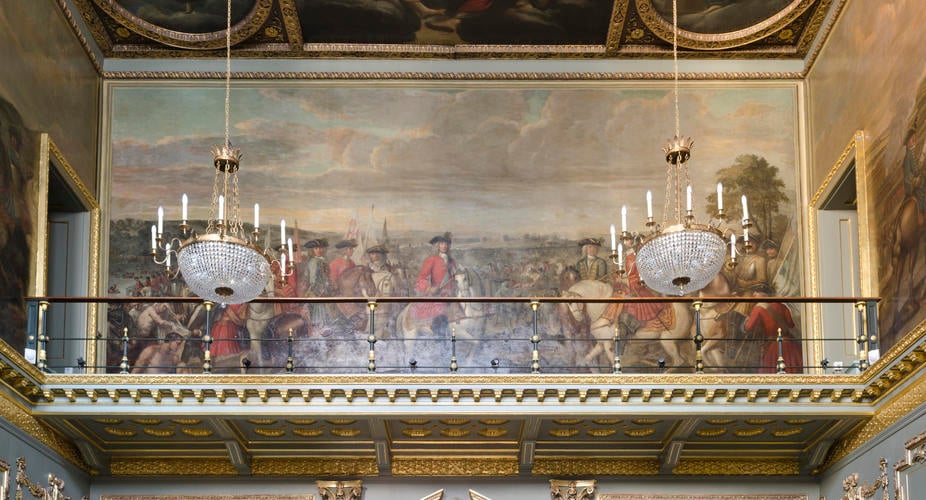-
1 of 253523 objects
The Battle of Blenheim, 13 August 1704: The Surrender of Marshall Tallard to John Churchill, 1st Duke of Marlborough (1650-1722) at the end of the Battle c. 1713-14
Oil on plaster | RCIN 408445
-
In 1713 Louis Laguerre was commissioned to decorate the walls of the main hall and the two flanking staircases of Marlborough House, the London residence of the Duke and Duchess of Marlborough. The subject was to be the significant battles of the Spanish Wars of Succession (1701-14); led by the Duke of Marlborough, Britain and the Allies saw victories at Blenheim (1704), Ramillies (1706), Oudenard (1708) and, less decisively, Malplaquet (1709). The murals were to be 'the only signs of bravura or ornamentation in a house that was otherwise very plain and simple' (John Charlton, Marlborough House, 1978). Laguerre was paid £500 for them. The murals have had a chequered conservation history and parts have been almost entirely repainted.
The main central hall (Blenheim Saloon) is decorated with the events of the Battle of Blenheim, 1704 (RCINs 408442, 408443, 408445). The window wall is painted with panels showing military equipment (RCIN 408444).
In 1700, when the death of Charles II of Spain threatened to plunge Europe into war, William III put John Churchill, later 1st Duke of Marlborough (1650-1722), then a relatively inexperienced and untried military leader, at the helm of British expeditionary forces, as part of the 'Grand Alliance' formed against France. The Spanish Wars of Succession (1701-1714) followed, which saw the 'Grande Alliance' of England, Austria, the Dutch Republic, the Holy Roman Empire, Piedmont-Savoy, Prussia, Portugal and Hapsburg Spain pitched into war against France, and France's supporters from amongst the monarchist regions of Spain that had automatically accepted duc'Anjou as Philip V.
At the conclusion of the battle, Marlborough and his company receive the surrender of Camille d'Hostun, duc de Tallard (Marshall Tallard) (1652-1728), the leader of the French army. Tallard, wearing the Order of the Saint-Esprit, is here led forward by William Cadogan, 1st Earl Cadogan (1675-1726). On the left, French forces can be seen fleeing into the Danube, where many of them drowned at the close of the battle. The spire of Sonderheim church and the turreted walls of Hochstadt can be seen in the right of the background, while in the foreground a wounded soldier is visible at left, with the tips of the French colours on the ground in centre.
Marlborough took Tallard from the field of battle in his own coach, which appears in Laguerre's depiction just behind the central figures, ready to take him away. After his capture he remained in confinement in Nottingham for the next eight years. The figure in a buff coat and cuirass behind Marlborough could possibly be identified as Prince Eugene of Savoy. Earl Cadogan is known to have presented Tallard to the Duke of Marlborough and so is almost certainly the figure next to the French Marshall on the right.An oil sketch on canvas, 72 x 138 inches, in Marlborough House until about 1724 and now at Grimsthorpe Castle; an small oil copy, 77.5 x 152 cm at Plas Newydd another, inscribed 'Hochstett', 29 ½ x 57 inches, last recorded at Adare Manor.
Provenance
Commissioned by the 1st Duke and Duchess of Marlborough
-
Creator(s)
-
Medium and techniques
Oil on plaster
Category
Object type(s)
